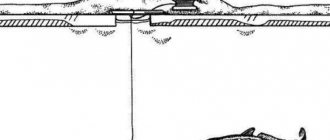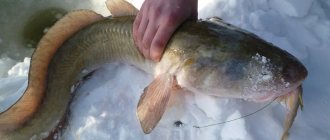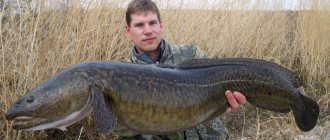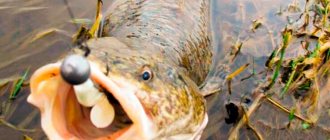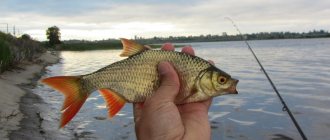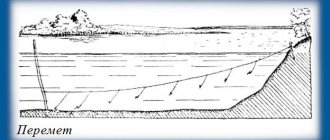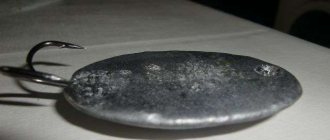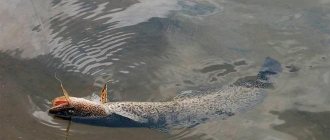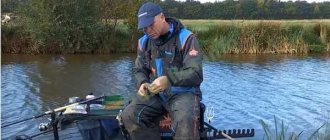Burbot is the only cod species that lives in fresh water. It is famous for its taste and liver, which is considered a delicacy and is very healthy. For burbot, like for any other fish, you need to choose the right key - bait. And although many different baits can be used to catch burbot, it is worth highlighting only a few of them that are to the taste of this fish and bring a good catch.
In this article we will look at all the baits that can be used to catch burbot and highlight the best among them. Let's figure out what time of year the best bait for burbot to bite on. Although burbot can usually peck at these baits both in March and November, there is still a slight dependence between the time of year and the preferences of burbot.
Burbot spawning
This bottom predator is one of the few fish species whose spawning period occurs exclusively in the winter months of the year. You can catch burbot during the mating season, because the reproduction process itself is periodic, and in the intervals between spawning cycles the fish feeds quite actively. Starting from the third ten days of December, when stable ice cover sets in, the fish gather in small schools on the pebble bottom and lay eggs. The breeding season lasts until March. In some regions of the country there are bans on catching predators within strictly defined calendar periods, which should be taken into account when developing fishing strategies . It is worth noting that it is after spawning that the moments of peak successful fishing occur, which gives the angler the opportunity to confidently plan fishing for burbot in the spring.
Important! We remember that by catching breeding fish, we significantly reduce its population, thereby reducing our chances of fishing success in future periods.
Features of burbot fishing
Content
This fish differs from the usual inhabitants of reservoirs in its habits and predilection for low temperatures.
Bottom representatives include fish
Let's consider the main nuances that you must know before starting the hunt:
- It is important to clarify whether it is possible to catch burbot in a particular region now. Catching cod fish is probably prohibited during spawning, and a ban on fish size has also been introduced in Russia. The fisherman is obliged to release the catch if the size of the individual does not exceed 40 cm, otherwise he will be fined;
- Find out in advance where you can catch burbot, if fishing is allowed. Sometimes authorities stipulate places where fishing is allowed. The fish itself belongs to the bottom representatives, so to catch it it is better to choose areas of the bottom with vegetation, snags or other obstacles;
- In the autumn-winter period of the year, fish spawning begins. The predator feels good in cold water, and at the stage of preparation for spawning, fishermen experience the most catchy time. The best fishing occurs from mid-autumn to mid-spring;
- in the summer, the only chance to catch fish is night fishing. Burbot does not like the sun's rays and prefers to hide from them, going out to hunt only at night. In general, it is ineffective to search for predators in rivers that warm up to a temperature of 25°C;
- Burbot is found at great depths and is a relatively passive fish, especially in summer. In warm times, it lies at the bottom, floating in a small radius. This feature makes burbot an easy prey for the “river giant” – catfish. If there is a large population of catfish in a river or lake or they are quite large, burbot most likely will not be found there.
Where to catch burbot
This peculiar bottom predator prefers rivers with strong and moderate currents, with relatively cold waters. The depth range of habitat varies from shallow waters with a water level of one and a half meters, to holes over ten meters deep. Bottom bases are preferable with rocky, multi-level linings, in which fish prefer to hunt at night and rest in the daytime. Burbot sites can also be on flat, hard bottom soils of sandy and clayey composition, but there must be cliffs or deep ditches nearby, with the possibility of hiding the predator in burrows or natural grottoes.

Favorite fish, promising fishing spots for anglers are the return flows on the edges and rifts of rivers, where the flow is divided into two streams, spinning whirlpools over pools with holes and bottom anomalies in the form of snags and various stones. The distance to the coastline has little effect on the predator’s lifestyle, and a parking spot can be found 2–3 meters from the shore. The muddy bottom and water thickets are absolutely unsuitable for searching for bottom predators. Clear water, strong currents and free spaces are its natural elements.
Distinctive features and distribution
In appearance, the fish is a bit like its distant relative, cod. A striking feature of the burbot is a small mustache on the lower jaw, the body is elongated, laterally compressed. The dorsal and anal fins are long, and there is also a short one on top. The color depends on the habitat and varies between dark brown and yellow shades. The ventral part is lighter from the tail to the head. The mouth is equipped with small, sandpaper-like teeth growing in one row.
The average weight of specimens that are usually caught on a hook rarely exceeds a kilogram; mostly small burbot are caught - up to 500 g. Further north in rivers such as the Yenisei, Akhtuba, Irtysh, Angara, Lena, larger specimens are found, sometimes reaching one and a half meters length and weight 15-18 kg.
Biologists' debate about the existence of different species continues to this day. Some claim that the fish is the only freshwater representative of cod, while others distinguish two more subspecies.
The predator spawns under the ice in January and February. He spends the summer in hibernation, hiding in the burrows of waterfowl rodents, snags and deep pools. It is not difficult to find the predator, it is distributed throughout the world, and this is by no means an exaggeration; it is successfully caught in Europe, Asia and even North America.
To learn more:
The best weather for pike fishing
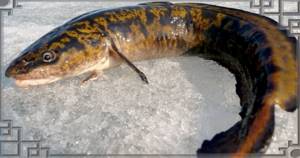
When is the best time to catch fish?
Burbot fishing is a seasonal activity, which is reasonable to plan only during the cold season. It’s worth noting right away that summer fishing is completely futile, unless you take into account the squinting method, when you catch burbot with your hands in holes. The main period for effective fishing sessions is the second half of October and until May.
Based on this time period, it is clearly clear that the predator can be caught both in open water and from under the ice. Daily fishing occurs especially during the dark and night periods. During the day, the fish does not show any activity. An interesting point is the activation of the bite based on weather conditions. Burbot begins to bite well when the weather deteriorates significantly and any other fish stops its activity.
Important! Sharp cold snaps, a significant increase in wind and an increase in precipitation, coupled with falling atmospheric pressure, give rise to successful fishing.
This is where you have the opportunity to use the vicissitudes of the weather to benefit your hobby.
Burbot biting calendar by month
| January | February | March | April | May | June |
| +++ | +++ | ++ | ++ | + | — |
| July | August | September | October | November | December |
| — | — | + | ++ | +++ | +++ |
Behavior of burbot in winter
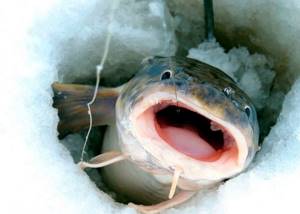
With the arrival of real cold weather, the behavior of burbot is standard. In other words, its autumn fishing almost imperceptibly, due to the nature of its behavior, turns into winter fishing. When the first ice appears on the winter fast rivers near the banks, burbot continue to be caught using bait. When reservoirs with standing water are covered with ice that can support the weight of the fisherman, they begin to catch burbot there using baits. Many species of fish, during the transition from autumn to winter, stop biting, as they spend a couple of weeks adapting to new conditions. As for burbot, it does not have such a period, and it continues to actively peck on all types of gear. Although some individuals begin to float to the ice itself, where they remain until the ice reaches a thickness of 10 cm, or even more. It seems that they decided to check whether access to the surface of the water was really blocked.
Interesting fact! During this period, our ancestors caught burbot using axes and light. People looked for specimens that stood close to the ice and killed them with the butt of an axe, after which all they had to do was cut the ice to pull out the fish. Pike and other types of fish were caught in the same way.
After the ice gets stronger, all the individuals are closer to the bottom, just like those that surfaced for reconnaissance, where they hunt for potential prey. After some time, having made an appropriate reserve of strength and energy, they begin to prepare for spawning. Burbots inhabiting rivers begin to move upstream, and burbots living in lakes move to pebble or rocky shallow water. Moreover, all this time the burbot steadily continues to take baits that are offered to it by fishermen using bottom gear and in the form of burbot lures.
Experts do not observe clear spawning dates for burbot, but it is known that this fish spawns in December-January, and in colder latitudes - from November to December. The trophy specimens spawn first, followed by the smaller ones. Individuals that have barely reached sexual maturity are the last to be sent for spawning. Due to this factor, the spawning process is greatly extended in time and it is almost impossible to say exactly when this fish spawns. Another interesting fact is worth paying attention to: spawning does not have any effect on the burbot’s bite, compared to other species of fish, which completely refuse to feed during the spawning period, with the exception of individuals that have not reached sexual maturity.
After spawning, burbot leaves shallow water, as well as other places, and moves to depth, where it continues to be caught using various gear.
What to catch burbot with
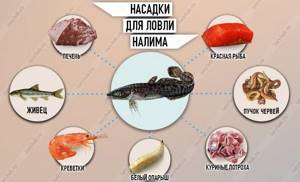
Let's consider the use of baits, focusing on the seasons of the year. Bait for burbot is only applicable of animal origin. The predator is indifferent to plant overgrowths. Of the artificial baits, only trolling allows you to hunt this sloth more effectively.
Autumn bait
The beginning of the hunting season is also characterized by a wide range of possibilities for using baits. Even in relatively warm water, worms are used for bait, ranging from dung worms to crawling worms. They try to catch larger specimens by stringing bait onto a hook in bunches of 5-7 specimens. The addition of fatty white maggots increases the chances of the fish quickly detecting the bait. Burbots respond well to chicken giblets with bovine or pork liver. Crayfish neck, carp fillet, defrosted shrimp, trimmings of fresh red fish will also be to the taste of the predator. For live bait in the autumn, it is worth using frogs and small bleak or roach. Even a dead fish placed on a burbot trail will become its prey.
Winter bait
In winter, you mostly have to fish from ice. Live bait allows you to successfully catch burbot. The best option for winter hunting is to install a ruff. Medium-sized live baits are slightly pressed down to reduce their activity and placed on the bottom. The use of roach, crucian carp and bleak is less effective. Among the alternatives to the ruffe, only the gudgeon can be distinguished, which is also artificially limited in its movements.
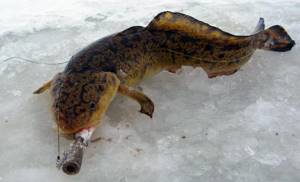
Burbot reacts weaker to dead baits and requires bait in the form of a bleeding liver or spoiled chicken giblets in places where the girders are installed. Winter is the time to use artificial baits, one of which is a burbot spinner in the form of a double spoon, the so-called snitch. Narrow pike perch spoons in silver and yellow-golden colors are also suitable for trolling.
Spring bait
In the spring they continue to fish with live bait, using ruffes and minnows. After spawning is completed, the predator’s menu also includes dead bait with a bleeding component, and therefore, the liver and fish fillet soaked in its own juice become effective bait tools. With the melting of ice, already in open water that is beginning to warm up, the amount of bait and its size on the hook are reduced, adding feeders to the equipment to attract a predator. The fish loses its activity and feeds in small portions, ignoring large pieces, instinctively going only to the smell of bait.
Summer bait
As discussed above, summer is not the best time for burbot fishing. But if you want to try your luck and test your skills, and the factors of the reservoir give you a chance of success, then you should try catching with bunches of worms. Lures should be placed in places where fast, mixing jets make the flow cooler compared to places where the calm, even flow of water is much warmer. Live bait is less preferred due to the scanty activity of freshwater cod in the warm season.
Features of choosing bait and bait for burbot
From season
The best time to catch burbot is from mid-October to early May. Burbot is most active during the cold season. A break in fishing may occur during spawning.
In the summer, it is almost impossible to lure burbot out of hiding; the fish is very sleepy and does not bite well. The best time in summer is cloudy, cold weather. You can use dead and frozen fish, frogs, and worms as bait.
A good time to catch burbot is early spring. In bad weather, you can count on a larger catch here than when fishing on a clear day. But it is best to catch burbot at night, because it is at this time that he is not very picky about food; he is also attracted to worms, frogs and any fish.
Winter is the ideal time to catch burbot, and this time should also be used to look for fish sites. Thanks to ice, you can try many places and find out exactly where the fish are. In winter, you can catch burbot with almost any bait: live bait, worms, shrimp, meat.
From the gear used
The most popular gear used in winter is winter bottom fishing rods. If fishing is passive, then they use girders. You can use any fish, worms, chicken giblets, or shrimp as bait. For winter fishing, you can also use tackle for the last vertical lure. Here you can use fillets of any fish, larvae, frogs, worms.
Very often, fishermen use fishing rods with a spoon; fishing rods with a jig are also good. Before choosing bait for a fishing rod with a spoon, you need to remember that you need to choose a fish for bait as close as possible to the fish that burbot feed on.
You can also catch burbot using large homemade jigs; their shape should resemble a cone. You can also attach a smaller tee to the bait. The bait should be light in color and shiny to attract fish. You can also use pieces of dead or frozen fish. Donka for burbot is also popular because it does not require expensive parts. Often fishermen make it themselves. It is recommended to use small pieces of fish as bait, which the burbot knows and often feeds on.
Catching burbot at different times of the year in different ways
The variety of methods for catching this type of fish differs in its application characteristics depending on the season of the year. Gear for burbot is similar to gear for catching other predatory representatives of fresh water bodies, only the small nuances of the installation itself are decisive in a particular fishing season. Further, as the article progresses, the rationale for using fishing methods based on these temporary changes will be given.
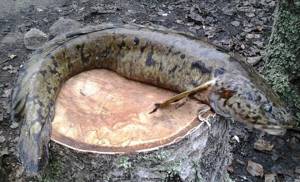
Spring burbot fishing
Spring time is divided into two seasons: the end of freeze-up and open water. On the last ice, it is effective to use two fishing methods: passive, using winter poles or stakes, and active, using winter spinning for trolling. When the ice melts, classic bottom fishing is used, which in its modern interpretation involves the use of a spinning rod, which is more preferable and more productive in terms of catches. Reducing fish activity requires precise placement of bait on the burbot trail, and accurate casting of equipment using a rod is much easier than adjusting a rubber donkey or fishing with equipment with floats.
Autumn burbot fishing
The season of greatest opportunities, when the angler has the right to use any equipment designed for catching this predator. The pre-spawning period forces the bottom sloth to make active night walks over considerable distances and the relevance of the trails becomes dull, which makes it possible to catch fish throughout the entire water area of its habitat. Classic bottom rigging, elastic bottom rigs, the use of float gear, girders and floating circles are suitable. The fishing methods are passive, requiring the angler only to install the rig itself and periodically check the rig for bites.
Fishing for burbot in summer
Summer is a period of calm for burbot. Fishing for burbot in the summer can be carried out using set-up baits and classic types of bottom rigs, leaving them in one place for several days, checking only the condition of the bait and possible isolated bites.
How to catch burbot in winter

Winter is a period of active fishing, when you can not only place bets and flags, but also work with a winter spinning rod, trolling large specimens on the trajectories of burbot trails and their camp sites spotted along the open water. They fish, as throughout the year, in the dark, starting to set up gear before dark and removing it after dawn. The spinning technique is based on tapping the spinner on the bottom and taking long pauses, up to half a minute, during which the attack occurs. The casting of the spinners is sluggish, without sharp explosions.
Read more about how to catch burbot in winter, choosing the most effective method and time.
How to catch burbot on a donk
The rod is mounted under the bottom using braided cords no thicker than 0.25 mm. For the sinker, a sliding version of the flat type is used, which allows the load to stay more reliably in the current. The mass is selected based on the current forces. Leashes are also used from a braided cord, half the diameter from the base.
Important! Metal leashes are not functional, since the fish cannot bite even a thick monofilament line.
Single hooks are used, with a long shank, no more than 12-14 numbers. After setting the bait, the equipment is cast to a promising fishing point and the rod is placed on the flyer, equipped with a sound alarm. Burbot bites are inert and in most cases unnoticeable. Having taken the bait, the fish remains to swallow it on the spot, and having swallowed it, it lies on the bottom and freezes. The time of such calm can drag on for hours and the fisherman, only checking the bait, discovers an already existing trophy with a deeply swallowed hook.
Important! A long, reliable extractor for burbot fishing is an important tool that helps improve fishing comfort.
Fishing with an elastic band
Rubber donks are used after the dead aquatic vegetation has been carried away by the current and the water streams have been cleared of dirt and floaters. Bottom tackle rigs are equipped with short, no more than 20 cm, leashes with hooks, in quantities from three to ten pieces, placed along the length of the cord every 5-7 meters. The leashes are loaded by the under-shepherd to press the bait as close as possible to the bottom of the reservoir. Multidirectional baits are hung on hooks to determine the preferences of predatory fish. Subsequently, they switch to the optimal option, which ensures a stable burbot bite. Leashes with live bait are supplemented with floats that do not allow live fish to hide in the stones.
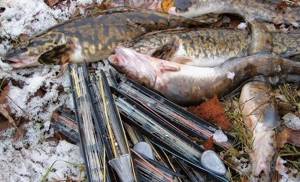
The balance of the float should hold the bait no higher than five centimeters from the bottom. Otherwise, such attachments will be completely ignored. Bites on a rubber donk are also not confident in their strength and are visually determined with difficulty. Self-notching in most cases is the logical conclusion of any bite. It is recommended to check the bottom at a certain interval, for example, every one and a half to two hours, monitoring all hooks for the integrity of the burbot bait and the caught fish. Fishing for a caught trophy is definitely amorphous in nature. The caught fish does not resist at all and is pulled ashore without much difficulty.
Fishing with float tackle

Catching a bottom sloth is possible using a float rod. If the angler knows a reliable anchorage point, it is not difficult to mount a simple float tackle for burbot using a fishing line, a sliding olive sinker, a single hook with a long shank and a float in the form of a boss, preferably with an illuminated high antenna, weighing up to ten grams. The rig can be installed on different types of rods - fly rod, Bolognese rod and match rod, making a choice based on the distance to the fishing spot. The bait is placed 5-7 centimeters from the bottom, controlling the retrieval along the required trajectory. The bite is determined by the sinking of the float.
After waiting a pause of ten seconds, they make a smooth hook with the rod itself. In most cases, the fish remains on the hook, since its attack on the bait involves completely swallowing the bait at once. Further fishing is carried out in the normal mode, winding the cord using a reel or, as in the case of a fly rod, simply pulling the trophy to a distance from which the fish can be taken into the landing net.
Night fishing for burbot

It is traditionally believed that burbot fishing is not entirely sportive and its simplicity reaches almost the primitive level of cave hunters, fishermen and gatherers. However, the number of burbot fishermen is not decreasing. Fiscal and selfish interest, you say... The gastronomic qualities of this strange fish, which is the lone relative of cod in our freshwater rivers and lakes, have long been known. That is why burbot has a delicious taste. Indeed, among its classmates are such fish as cod, haddock, pollock, pollock, navaga, wachnya, silver hake and Pacific hake. Burbot liver is similar in taste to cod liver, which is recognized as tender and revered by gourmets. But before spawning, burbot tend to compress and reduce this potential delicacy, preparing a place for eggs. Therefore, the autumn nocturnal predator, which itself is fat, does not have such a large and white liver as in the spring.
But it’s not just burbot fish soup and tender liver that make fishermen sit out nights by the frozen river. It is the magic of these very nights with the hooting of an eagle owl on the full moon, the splashing of water and the mournful cry of a night bird or a green-eyed witch at a sabbath that disturbs the heart and warms the blood... And when the soft ringing of the bell of a snooker is woven into these infernal sounds, the fisherman seems to be thrown up from a heated bed by the fire! For him, this bell sounds like an alarm bell and is the very main thing for which he is ready to freeze on frosty nights...
Zakidushki Without a doubt, zakidushki are the most affordable, simple, catchy and practical gear for night burbot fishing. I made this conclusion for myself a long time ago, based on the experience of numerous night fishing trips. But my comrades, who came to catch burbot for the first time with their proven feeders, also came to the same conclusion. Convenient and long-range, these tackles are unrivaled in the daytime. On cold and dark nights they become cumbersome and difficult to cast, even with a flashlight. Of course, an experienced angler with a feeder can cast his tackle quite accurately. I was convinced of this on one of my last fishing trips, when a friend, whose name is Anton, accurately threw a cut roach under the most fallen tree on the opposite side of the river. But burbot reaches require more than two or three tackles, especially if there are not so many burbot in this place. Often, in order to find a fish trail, you have to check a dozen places on the reach. Carrying so many feeders with you and putting them out at night will not be the most exciting thing.
So, throwaways... The simplest option is a reel with a fishing line, a heavy sinker weighing about 200-250 g and one or two leashes with hooks. At one time, for convenience, I put only one leash, since there was a lot of burbot and he took it mainly on the first leash from the sinker. But since when catching burbot, worms, cut fish, and live bait can serve as bait, it is still better to use two leashes. The tackle will then be more rational and versatile due to various baits. In addition, often the worms are eaten by underwater small things, and then the stash will be wasted. And since the burbot takes from the bottom, you can place the first leash in front of the sliding sinker.
As for bait, I have repeatedly been convinced that in the fall burbot prefers cutting or small live bait: roach, gudgeon, its brother - small burbot, and, of course, the fish of its dreams and gourmet claims... Ruff! Let it be snotty, incredibly prickly, but so desirable! And there is no need to trim the spines of the ruff. Burbot somehow knows how to fold them neatly and swallow the ruff along with them. Larger fish are caught with these baits than with a worm. In the spring, a large brush of worms is more likely to be suitable. These can be subfoliates, dung worms, crawlers. However, it is likely that in other bodies of water and regions everything is also different.
Sinkers, of course, are better suited to a flat shape. Traditionally they are cast in a tablespoon. But in the spring they will be easy for the strong pressure of melt water. I cast heavier weights in a mold hollowed out in sand-lime brick. Since the shape turned out to be rough, the sinkers came out rough after casting. But this was their advantage, since they held better on the sandy bottom. In the fall, sinkers cast in a tablespoon are quite suitable for shallow rivers, but not every year. There are also autumn floods after prolonged rains.
It is better to use large hooks for catching burbot with a long shank. This will make it easier to get them out of the mouth of the slippery fish, which scratches the fisherman’s hands with its small teeth. A more practical way is not to remove the hooks at all, but to unfasten the leads from the fasteners on the main fishing line and install spare ones prepared in advance. Usually it is much easier to do this in an icy wind or frost at night. Now about bite alarms. Still, feeder bells are not as audible from a distance as real brass or nickel-plated bells. Of course, now you don’t always find such bell-shaped products. Only if old stocks are still available. Sometimes you can find something similar on sale, but for some reason painted with paint... This is probably as a protection against corrosion, instead of nickel plating. The products are most likely Chinese consumer goods. Experiments with brass sleeves have shown that the real ringing of old bells still cannot be achieved. But somewhere and somehow you can still find them, at least similar ones. The bell is secured to the main line using a loop threaded through the bell's eye and then draped over the bell. The bell is passed through the loop and the line is tightened. Simple and fast, which is very important in night fishing. I admit, I don’t even always remove the bell after selecting the fishing line from the water, since the installation scheme for the hook is also simple. A reel with a supply of main fishing line is attached to a flexible willow rod. The fishing line measured to the required length lies on the sand, preferably folded in wide rings. (In this case, it is necessary, having first dropped the required amount of fishing line from the reel, to rewind it back into the rings. Then there will be no tangles when casting). After casting, the fishing line is inserted into a split willow rod and a bell is hung on it. Having chosen a line with burbot or... a skein of grass, I sometimes simply throw the tackle along with the bell. So he gurgled in the water, and I pulled him back, and then inserted the fishing line into the split. I rinse the bell with water to remove sand so that it doesn’t lose its crimson ringing. This is probably wrong, but when your hands are cold, you don’t want to deal with loops and other annoying little things. And one more important detail. This is a reel. Store-bought, thin, plastic and openwork reels will most likely break on the very first fishing trip. It’s better to cut them out the old fashioned way from strong and thick plastic or, at worst, from plywood. The latter, of course, warps from water, but is strong and elastic. Reels made from boards will also work.
Donkey Here we will talk about devices for casting tackle in grassy areas, among dead wood and even in bushes, which are not accessible for casting. The fishing line will simply catch on all these obstacles. The simplest donkey can be called an ordinary elongated tin can or plastic bottle. This will also be the simplest inertia-free reel. True, here it will no longer be possible to equip the donk with a thick fishing line of 0.6-0.7 mm, but 0.4 mm will do. The fishing line is wound around the can, and casting can be done in the strongest places. But I used a more convenient version of the gear. For her, I prepared a Volga side fishing rod, without even removing the flexible guard spring with a bright ball at the end and a small bell. Only in front of the guardhouse he placed a rather large ring. I equipped the fishing rod with a spinning reel and the result was a simple donkey model. Casting is done not with a rod, but with your hand, since there may simply not be a place for casting with a real spinning rod on the shore because of the bushes. Essentially, this is the same can with fishing line, only more convenient. Moreover, there is already a ready-made gatehouse with a bell. After casting, the line is selected and placed in the slot on the guard. That's it... All that remains is to install the rod vertically in the flyers, and the tackle is alert. It is not necessary to have a set of these side rods with you. They are used along with snacks only where there is a need. And such a need arises when the clear reach is too small for several fishermen and you have to go beyond its boundaries. Usually willows and grass begin behind them. It should be noted that it is better to cast baits and donks from a low sandy shore-beach, since the opposite side is often steep and snaggy, where burbot hang out during the day. At night, he goes out onto the rifts and edges of his pit-house. Well, it’s clear that when you throw it into a snagy hole, you’ll simply leave your gear in it. All of the above applies to small forest rivers.
